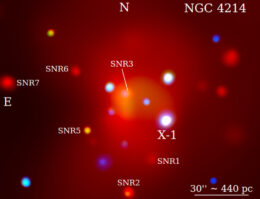
An X-ray view of the dwarf starburst galaxy NGC 4214 created from Chandra X-ray Observatory Data. [Adapted from Lin et al. 2023]
Ten million light-years from Earth, a tiny galaxy that glitters with new stars houses a rare kind of binary system. The binary, cataloged as CXOU J121538.2+361921 and referred to simply as X-1, is the brightest X-ray point source in its home galaxy. The system’s bright X-ray light is the result of a star having its atmosphere stolen by a compact companion, like a black hole or a neutron star, creating an extremely hot accretion disk. In a recent research article, a team led by Zikun Lin (Key Laboratory of Optical Astronomy, Chinese Academy of Sciences; University of Chinese Academy of Sciences) used data from the Chandra X-ray Observatory and the Hubble Space Telescope to learn more about this unusual system. The Chandra data, shown to the right, allowed the team to confirm that the binary components eclipse each other every 3.6 hours. The Hubble data, shown above, allowed them to identify the optical counterpart of the X-ray binary for the first time: a blazingly hot blue star that is likely a massive, evolved star with powerful winds and a metal-rich atmosphere. In some tens of millions of years, this star and its companion — the team suspects a black hole, though a neutron star can’t yet be ruled out — will lose their orbital energy to gravitational waves and coalesce in a spectacular cosmic explosion.
Citation
“On the Short-period Eclipsing High-mass X-Ray Binary in NGC 4214,” Zikun Lin et al 2023 ApJ 954 46. doi:10.3847/1538-4357/ace770


